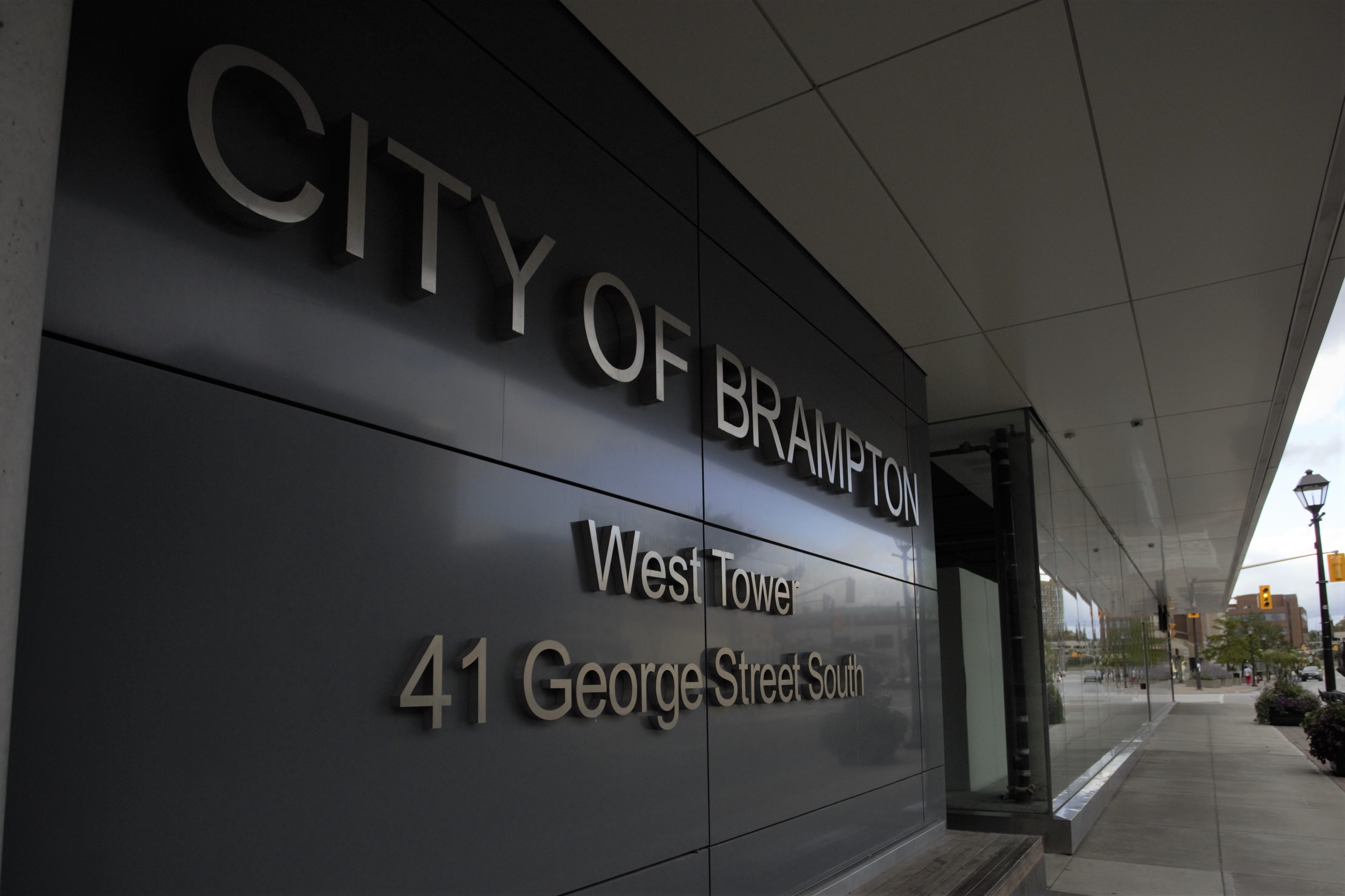
Lawsuit’s defeat comes after former citizen of the year who built Brampton City Hall exposed widespread misconduct
Brampton’s City Hall West Tower expansion rises above the low-slung surrounding blocks of the aging downtown, resembling a giant three-dimensional barcode. It was supposed to be the centre piece of a half-billion-dollar redevelopment to reanimate the struggling area.
The charcoal-coloured L-shaped structure serves as a $205-million reminder of how not to handle a public procurement paid for by local taxpayers.
The controversial building was the focus of a $28.5-million lawsuit filed by Inzola Group, owned by the man whose company had built the original City Hall thirty years ago. After the courts recently ruled against John Cutruzzola in his appeal of an earlier decision, he has decided to walk away from the legal action he launched in 2011, satisfied that the process successfully exposed the wrongdoing by former staff and officials whose conduct is documented in the reams of publicly available evidence that now sits with the courts for anyone to see.

(Photo: The Pointer Files)
Recently, the City of Brampton expressed its satisfaction with the rulings and claimed the decisions illustrate procurement practices inside City Hall are above board. The evidence in the case, which is now over after Inzola decided it will not file another appeal, shows the process around the half-billion-dollar development deal was riddled with secrecy and involved widespread misconduct by former City officials.
Former mayor Susan Fennell thanked Council members last week for the public statement that was issued. She was resoundingly defeated in the 2014 election, garnering just 12 percent of the vote after a series of scandals revealed to taxpayers the extent of her abuse while she held Brampton’s top public office.
The lawsuit revealed that Fennell, without council’s knowledge, had signed a $480,000 contract with the successful bidder in the downtown deal, Dominus Construction, using public taxpayer dollars to secure property for the project the company was supposed to acquire on its own, without any assistance from the City.
The Inzola lawsuit, which alleged the company was unfairly disqualified from the bidding process and that Fennell and other officials were biased against the local builder, did not include any allegations against Dominus, which stated it followed all rules in the entire process.
The lawsuit pointed out the company’s president, Joseph Cordiano, a former Ontario MPP and cabinet minister, worked at Queen’s Park at the same time as Brampton’s city manager, Deborah Dubenofsky, when she was employed as a deputy chief of staff in former premier Mike Harris’s office. She was a prominent figure in the case.
What was supposed to be a half-billion-dollar downtown redevelopment never happened after only the first of three phases of the planned project moved forward.
The eventual ruling of Justice John Sproat found Inzola was legitimately disqualified and did not find there was bias on the part of City officials against the builder.
Sproat admitted the securing of the required property involved misconduct. He wrote in his decision that when council members asked simple questions about whether Dominus had secured the property in 2011, when senior staff claimed the company had done so, council “did not get” a straight answer. Staff lied to council, and at least one former member, John Sprovieri, testified that had he known Dominus did not have the required property secured in 2011, he would have voted against the deal, which would have forced the whole process to be cancelled.
Other councillors testified that had they known they had been lied to, they would have demanded staff be fired for misleading the public.
Eventually, all of the staff involved in the case were let go by the City, after the evidence was revealed through the lawsuit. The City stated it was a result of restructuring.
Dubenofsky, the former city manager, who led the bureaucracy when the bidding process for the massive project was undertaken, left the City after the lawsuit was filed and council decided not to renew her contract in 2012.
She repeatedly admitted on the witness stand during the 2018 trial for the lawsuit that she had previously misled the court.
Dubenofsky was not part of the bid selection committee and was not supposed to see any details around the tendering process including the documents submitted by the three companies vying for the job. She was only supposed to deal with timelines and other process-related issues so she could keep council informed about how the tendering was progressing and when votes would be taken to approve the eventual deal.
For a pre-trial motion in 2016, Dubenofsky testified under oath that she dealt only with the final versions of reports by the selection committee, just before they went to council, to ensure brevity.
During a hearing before the Ontario Superior Court in an Orangeville courtroom in June of 2018, Inzola’s lawyer, David Chernos, read Dubenofsky’s 2016 transcript back to her. He then presented the court with documents, obtained from the City after she had given her initial pre-trial sworn testimony. The court had compelled the municipality to produce the information, which showed Dubenofsky had misled the court in her original testimony.
“You said: ‘I would see the very final, last draft, the very last draft, that’s correct.’ But that’s not correct, is it?” Chernos asked Dubenofsky.
“No, it is not,” she responded, her voice cracking as she admitted to providing misleading testimony under oath.
“Your evidence was not true.”
“I concede there were inaccurate statements,” she said, her face turning light red. “I was incorrect.”
Chernos pressed further. Her admission to having dealt directly with early versions of the reports “is directly contradictory to what you testified to in 2016, isn’t it?”
“Yes,” she responded.
Chernos repeated her evidence from 2016, showing more documents the City had been forced under court order to produce, contradicting her original testimony. Dubenofsky repeatedly responded that she had been “incorrect” in 2016.
Chernos then took Dubenofsky back to her 2016 testimony regarding her role in handling what were supposed to be the independent reports of external “fairness advisor” James McKellar, who was hired by council members to report directly to them about his oversight of the selection committee, to ensure the procurement process was carried out fairly.
The trial heard that McKellar was the same person senior staffer Julian Patteson, the City’s point person for the entire procurement and vice chair of the selection committee, had originally recommended the city hire to help design the unique, procurement process for the deal, which had been used in Europe but never in Canada before. McKellar has promoted the concept around the world. Patteson testified that he had met McKellar years earlier, through conferences and organizations related to municipal real estate.
Inzola’s lawyers probed whether the overlap of McKellar’s roles—between design of the process and accountability for how it was carried out—represented an obvious conflict of interest. The lawyers questioned how he could properly hold accountable his own recommended method (which the city paid him to help create) and the staff using his method, who had selected him for both roles.
Dozens of court-ordered documents entered as evidence by the plaintiff suggest staff were heavily involved in drafting and re-drafting McKellar’s reports, though they were supposed to go directly from him to council.
Chernos repeated the words Dubenofsky said under oath in 2016, about treatment of the independent fairness advisor’s reports to council. Paraphrasing from the 2016 transcript: “You didn’t have to involve yourself at all — no review of drafts (of McKellar’s reports) even final drafts.”
“That testimony you gave was also untrue, wasn’t it?” Chernos said.
After he again repeated her 2016 testimony, where she said under oath that she had “no involvement” in drafting the fairness advisor’s independent reports, Chernos put to her: “You weren’t correct.”
“Yes, it was incorrect,” Dubenofsky replied.

Deborah Dubenofsky (Facebook)
The decision to disqualify Inzola from the bidding competition in 2010, which Dubenofsky was not supposed to be involved in, was another central issue in the lawsuit.
Dubenofsky testified in 2016 that she had “found out when the public found out” about one of the issues that led to Inzola’s disqualification, according to court transcripts. “No more involvement than the public—that was your evidence, correct? That was just flatly untrue, wasn’t it?” Chernos asked.
“It was incorrect,” Dubenofsky replied.
Documents entered as evidence in the Inzola lawsuit showed that, contrary to Dubenofsky's 2016 testimony, she was aware of the disqualification issue from the beginning and directed staff to keep her closely informed. The documents do not indicate Dubenofsky was responsible for making decisions on issues that led to the disqualification, or the ultimate decision to remove Inzola from the competition.
In his final decision, Sproat ruled that Inzola was legitimately disqualified when it attempted to get answers around an unprecedented, highly secretive demand the City made of the company. After Inzola submitted its bid in 2010, in response to the RFP for the project, it was forced to sign a confidentiality agreement that would have prevented it from ever revealing details of its bid, including the cost to construct the West Tower City Hall expansion.
The company sensed something was not right and requested that its bid only be kept confidential throughout the selection process, the standard practice in such procurements. Inzola felt the City was trying to prevent the public from ever knowing what a fair price was.
The City refused to change its unusual demand, and when Inzola attempted to address council about the issue, staff determined the action was a violation of the RFP and disqualified Inzola.
Sproat viewed the narrow aspect of the RFP which dealt with communication provisions and ultimately decided that under the specific language of the bid rules, the disqualification was justified.
He did not rule on the vast majority of the evidence that was produced in the case, as the judge felt most of the information was not relevant to the specific issue of whether the disqualification was allowed.
Cutruzzola told The Pointer he never intended to accuse any staff who conducted themselves professionally of wrongdoing.
“Look, the evidence could not be any more clear. It showed who was not telling the truth. In public administration, in civil service, the servants of the public have to operate at the highest standard,” he said. “When we look at the breakdown of democracy, what are we talking about? It’s the failure of our public institutions to uphold values of fairness and justice.”

John Cutruzzola, Brampton's former citizen of the year, built the original City Hall opened in 1991.
“I’m obviously not happy with the outcome of the case and will not pursue another appeal. But we already accomplished everything that we set out to do. The evidence is right there for everyone – the truth came out, that’s all I ever wanted for the public.”
Cutruzzola said the lawsuit was never about the money. “I said publicly that any money that might have been won, would go back to community organizations, a new hospital for Brampton and other local needs – all of it.”
Inzola’s bid was about half the price of the Dominus proposal. Taxpayers are paying $205 million over 25 years, and the winning bidder eventually walked away from the project, selling its rights to Fengate, a private real estate investment firm.
Inzola’s proposal would have cost taxpayers $110 million.
The public was shocked when it learned through the lawsuit that taxpayers could have had the City Hall expansion for $95 million less.
Fay Booker, a procurement expert hired under direction from council after the lawsuit was filed, told members after Fennell was defeated in the 2014 election, that the City spent tens of millions more than it should have on the expansion.
Chris Bejnar co-founded the group Citizens For a Better Brampton because of concerns that emerged across the municipality around the City Hall expansion project. He was disappointed with the court decision but says everyone he knows is aware of what the evidence revealed.
“It seems like there are different laws applicable to public officials than those applied to average citizens. So much evidence came out of the case that showed the lying and deceit that occurred, but the judge’s focus was on such a narrow sliver of the case.”
Bejnar said Fennell was removed from office in an overwhelming defeat because taxpayers were tired of her abuse of public funds and disrespect for the hard-working people she was supposed to represent.
“And all the staff involved were removed,” he says. “Whether it was because of ‘restructuring’ or actually because the new leaders of the administration (at the time) didn’t want to work with them, the fact is, they are thankfully no longer here.”
Bejnar won his own fight with City Hall after staff in 2011 refused to provide the square footage cost of the building. The Information & Privacy Commissioner of Ontario ordered the City to reveal the cost breakdown, which showed taxpayers were paying about twice the price for the building compared to industry standards.
“All the testimony and tens of thousands of pages of documents, of irrefutable evidence is now public. It’s disappointing that the judge chose to rule the way he did, disregarding the mountain of evidence, but that doesn’t change what happened.”
Bejnar says the case will stand up for a “long, long time.”
“I hope the lawsuit will prevent staff or officials from ever trying to abuse the taxpayers again.”
The evidence also showed senior staff had minutes of meetings altered after Inzola filed its lawsuit, to remove statements that showed they were biased against the company.
Patteson repeatedly denied on the witness stand that one of the minutes, which recorded a particularly damning remark made by staff against Inzola, was altered. But the man who made the statement, Mo Lewis, then testified he had indeed made the comment at the meeting in front of Patteson, but the remark was later removed from the minutes.
“The City claims the decision shows its procurement process is above board, but the case showed that’s far from the truth, and look at what’s happening inside City Hall now,” Bejnar said.
He referred to an ongoing third-party investigation into allegations of widespread corruption, including procurement practices inside City Hall, made by a current senior staffer, supported by recent allegations by former staff.
During the trial, Dubenofsky was asked about her treatment of Bejnar, a taxpayer who had expressed concerns about the secretive nature of the procurement and the cost of the City Hall extension.
Chernos showed her a 2011 email in which she described the long-time Brampton resident who lives near City Hall as a “clown” to senior staff.
Chernos asked if she had told council members not to speak with Bejnar. That was her advice, she testified.
She was then shown emails between herself and Fennell suggesting they schedule the crucial vote to decide the outcome of the bid competition while one of the council members opposed to the way the process had been handled would be away on vacation.
Dubenofsky denied trying to stack the vote in favour of the staff recommendation.
The recommendation report to council ahead of the crucial March 2011 vote, included fabricated information, telling elected officials the selected bidder had acquired the property required for the project, even though Patteson and other staff who put the report together knew this was not true.
Dubenofsky was then shown an email in which she instructs her assistant to “Go slap him,” after former councillor John Sanderson, who was also against the deal, raised a complaint from a resident shortly after construction on the project began.
Dubenofsky testified that it was a “regrettable lapse in professional decorum.”
Despite Sproat’s opinion that the City was not biased against Inzola or Cutruzzola, there was obvious proof of clear bias in the evidence, from disparaging remarks made by Patteson in closed meetings to documents that showed staff did not want to give the company another chance at the contract.
But the most obvious evidence of bias against Cutruzzola was contained in shocking allegations the City made in its initial response to the lawsuit filed with the court.
Two months before the trial began, the City removed from its filed statement of defence damning allegations accusing Cutruzzola, without a shred of supporting evidence, of influence peddling and corruption, suggesting the man who built the original City Hall could not be trusted.
It was a stunning claim, that revealed the extent of the bias former City officials had toward Brampton’s former citizen of the year.
For years during the pre-trial process, Inzola asked that the allegations either be withdrawn or the evidence to support them be provided. Despite the repeated requests the City refused and the fabricated accusations remained in the public record for years.
Perhaps realizing that without any evidence the false accusations by the City proved Inzola’s central allegation of bias, they were withdrawn at the eleventh hour. But that didn’t change the fact they had been made and stood on the record for half a decade.
Chernos pressed Patteson, the City’s chief witness, during his cross-examination, about how the damaging allegations against Cutruzzola came about.
"Were you involved with instructing outside counsel for this litigation?" Chernos asked, referring to the lawyers who had represented the city.
"I don't know who it was," Patteson replied.
"You were the main witness in discovery, you swore affidavits, and you don't know who gave instruction to outside legal counsel (for the allegations in the 2013 statement of defence)?" Chernos said.
Chernos appeared to lose his patience. He made it clear that the unsubstantiated accusations showed a clear bias against his client.
"Inzola asked (during the discovery process) for how the allegations were reached.” The City eventually admitted there were no facts to back up the allegations. “They were not withdrawn until five years later, March this year," he said. Chernos waited for a response, looking directly at Patteson, who kept his head cast down, and remained silent on the witness stand.
Chernos continued. "Who instructed outside counsel to make these claims and then refuse to withdraw them, even though they could provide no evidence to back the claims?"
Chernos demanded that Patteson respond.
He remained silent.
Not one witness for the City would tell the court who instructed lawyers to claim Cutruzzola was corrupt.
In the end, regardless of the decision in the case on a narrow interpretation of one factor, the man who built Brampton’s original City Hall says the truth, after a decade-long struggle, is right there for everyone to see.
Email: [email protected]
Twitter: @JoeljWittnebel
COVID-19 is impacting all Canadians. At a time when vital public information is needed by everyone, The Pointer has taken down our paywall on all stories relating to the pandemic and those of public interest to ensure every resident of Brampton and Mississauga has access to the facts. For those who are able, we encourage you to consider a subscription. This will help us report on important public interest issues the community needs to know about now more than ever. You can register for a 30-day free trial HERE. Thereafter, The Pointer will charge $10 a month and you can cancel any time right on the website. Thank you.
Submit a correction about this story


